March 1622: Sao Jose, a Portuguese Trade Vessel, Loaded with Spanish Silver Reales Lay at Anchor at Lisbon
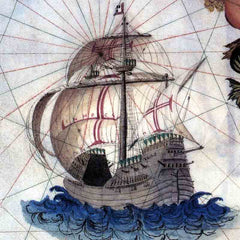 In 1622 Spain was ruled by King Philip III of Spain… and Portugal was ruled by King Philip II of Portugal, who were, yes, the same guy. So, obviously, Spain and Portugal were allies united under a common king.
In 1622 Spain was ruled by King Philip III of Spain… and Portugal was ruled by King Philip II of Portugal, who were, yes, the same guy. So, obviously, Spain and Portugal were allies united under a common king.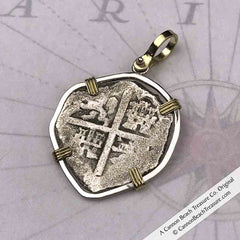 It was under the jurisdiction of this common king that the Sao Jose and its small fleet lay at anchor in March of 1622, preparing for their voyage to Goa, India, where they would deliver a vast sum of silver Spanish reales (in fact, nine chests filled to capacity with thousands of “Pieces of Eight”) to Portugal’s largest trade center on India’s western coast, as well as a VIP you may have heard of (or at least his surname will sound familiar)…
It was under the jurisdiction of this common king that the Sao Jose and its small fleet lay at anchor in March of 1622, preparing for their voyage to Goa, India, where they would deliver a vast sum of silver Spanish reales (in fact, nine chests filled to capacity with thousands of “Pieces of Eight”) to Portugal’s largest trade center on India’s western coast, as well as a VIP you may have heard of (or at least his surname will sound familiar)… The VIP? The newly appointed Viceroy of India: Francisco da Gama – the great-grandson of legendary explorer Vasco da Gama, who was the first European to arrive in India via a sea route.
The VIP? The newly appointed Viceroy of India: Francisco da Gama – the great-grandson of legendary explorer Vasco da Gama, who was the first European to arrive in India via a sea route.
Preparations for the voyage were proceeding according to plan when fate stepped in – and the foundation for Sao Jose’s eventual demise was laid with just one report from abroad.
Image 1: A Portuguese Carrack - the forerunner of the famed Spanish Galleon of the Spanish Treasure Fleets
Image 2: An authentic Spanish Reale recovered from the shipwreck Sao Jose
Image 3: Legendary Explorer Vasco da Gama
Now, before we continue our story… please indulge a historian’s musing, but whenever a story about shipwreck Pieces of Eight of the, let’s say 1500s – 1800s begins, you know the story will almost always include at least three to five of the following: the Spanish, Dutch, British, Portuguese, French, and, of course: Hubris, Hurricanes, Islands, Reefs, Pirates and, not to be forgotten… Really, Really Bad Navigation.
Back to our story… Sao Jose Sets Sail
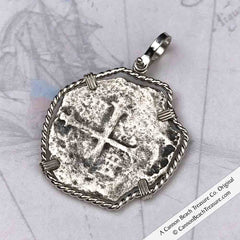 The small fleet is laying at anchor when a report of a most alarming nature reaches them: the British are rumored to be planning an attack on the island of Hormuz – a tiny but incredibly valuable piece of strategic real estate (both then and now) located right where every European country looking to dominate the Indies trade route would want it to be – smack dab in the narrow straight between what is now called the Persian Gulf and Gulf of Oman. Known as the “Gateway to the Spice Trade” this narrow straight is the only sea route through the Persian Gulf to India.
The small fleet is laying at anchor when a report of a most alarming nature reaches them: the British are rumored to be planning an attack on the island of Hormuz – a tiny but incredibly valuable piece of strategic real estate (both then and now) located right where every European country looking to dominate the Indies trade route would want it to be – smack dab in the narrow straight between what is now called the Persian Gulf and Gulf of Oman. Known as the “Gateway to the Spice Trade” this narrow straight is the only sea route through the Persian Gulf to India.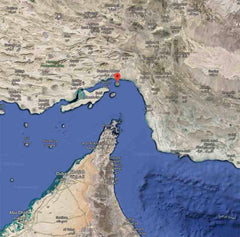 While Hormuz was visited by Venetian explorer Marco Polo around 1290 while traveling overland, it wasn’t until the Portuguese expansion in Africa and western Asia at the dawn of the 16th Century, that Hormuz would become a European prize. In 1507, the island was captured and claimed for Portugal by Afoso de Albuquerque and became part of the expanding Portuguese empire. A fort was quickly constructed to deter invasion, and Hormuz became a vital safe refuge and stopover point for Portuguese vessels traveling to Goa and beyond.
While Hormuz was visited by Venetian explorer Marco Polo around 1290 while traveling overland, it wasn’t until the Portuguese expansion in Africa and western Asia at the dawn of the 16th Century, that Hormuz would become a European prize. In 1507, the island was captured and claimed for Portugal by Afoso de Albuquerque and became part of the expanding Portuguese empire. A fort was quickly constructed to deter invasion, and Hormuz became a vital safe refuge and stopover point for Portuguese vessels traveling to Goa and beyond.
But the British and Dutch East India Companies – with their own dedicated military and an eye on increasing their successful trade with the Indies – wanted Hormuz for themselves.
And so, with almost reckless speed, Sao Jose and the rest of the fleet set sail to rush to the protection of one of their most vital outposts.
To see our exclusive collection of Sao Jose shipwreck coin jewelry, click here>>>
Sao Jose's Voyage Begins... and Ends
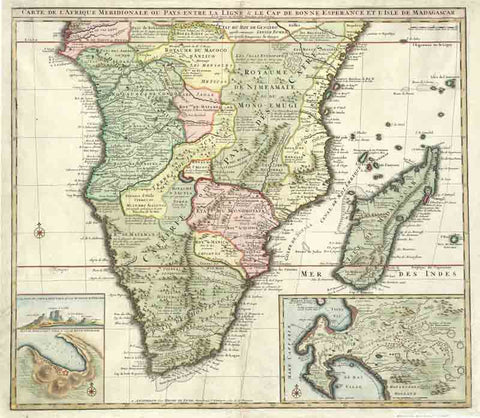 The voyage around the Cape of Good Hope went to plan, and the fleet was soon headed up the familiar route hugging the East African coast to enter the Straight of Madagascar. Little did they know that they were literally sailing into the jaws of a powerful combined Dutch and British East India Company fleet just waiting to attack the smaller Portuguese flotilla.
The voyage around the Cape of Good Hope went to plan, and the fleet was soon headed up the familiar route hugging the East African coast to enter the Straight of Madagascar. Little did they know that they were literally sailing into the jaws of a powerful combined Dutch and British East India Company fleet just waiting to attack the smaller Portuguese flotilla.
Image 4: An authentic Piece of Eight recovered from the 1622 shipwreck Sao Jose
Image 5: The island of Hormuz - the Gateway to the Spice Trade
Image 6: Southern Africa and the Mozambique Channel in 1730 - printed in Amsterdam
It was a dusk on July 22, 1622 as the fleet sailed up the Mozambique Channel, that the alarm was sounded, and soon the worst fears of the fleet were confirmed: they had sailed right into the ambush and were under attack. As was her appointed duty as Almiranta, Sao Jose was bringing up the rear of the fleet, and was trailing the others – the perfect position to be picked off and surrounded by the Dutch and British. Surrounded, horrifically out-gunned, and reportedly taking more shots than any recorded single vessel attacked in the Indian Ocean ever had, Sao Jose was desperately fighting just for survival. As battle continued, the ship’s captain and most officers fell ill or were injured, and the pilot and commanding officer were soon killed. Through it all, Sao Jose remained navigable throughout the night and into the next day. Despite the fact that Portuguese ships were legendary for battling to the end, in the face of the unending barrage, Sao Jose had no choice but to flee toward the African coast. But, coasts often spell disaster rather than refuge, and this stretch of the coast was no exception – the mighty Almiranta Sao Jose ran right into a shoal. The resulting collision sheared off her rudder, and she was now helpless; drifting with wind and wave, awaiting whatever fate would bring.
As battle continued, the ship’s captain and most officers fell ill or were injured, and the pilot and commanding officer were soon killed. Through it all, Sao Jose remained navigable throughout the night and into the next day. Despite the fact that Portuguese ships were legendary for battling to the end, in the face of the unending barrage, Sao Jose had no choice but to flee toward the African coast. But, coasts often spell disaster rather than refuge, and this stretch of the coast was no exception – the mighty Almiranta Sao Jose ran right into a shoal. The resulting collision sheared off her rudder, and she was now helpless; drifting with wind and wave, awaiting whatever fate would bring.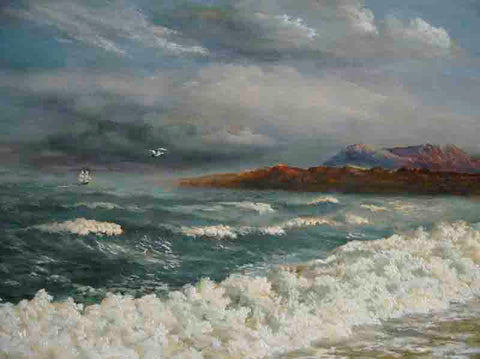 Despite the horrors the crew had survived, they mounted a heroic effort to somehow save their ship. Precious brass cannons were thrown overboard, anchors were dropped, and anything deemed non-essential was tossed into the sea in an attempt to lighten the thundering vessel.
Despite the horrors the crew had survived, they mounted a heroic effort to somehow save their ship. Precious brass cannons were thrown overboard, anchors were dropped, and anything deemed non-essential was tossed into the sea in an attempt to lighten the thundering vessel.
But it was far too late. Sao Jose reached her final port of call on a reef off the Mozambique coast after the pursuing Anglo-Dutch fleet mounted what would be a final attack. Soon ship, crew, passengers and cargo were scatted on the bottom of the Mozambique channel.
Image 7: Spanish and Dutch Fleets - and Unknown Dutch Master Active in Amsterdam in 1651
Image 8: A ship drifts perilously near the reef
The Recovery of Sao Jose's Spanish Shipwreck Coins
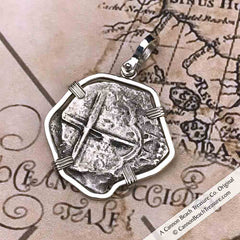 Interestingly, the Dutch and British were able to recover a small fraction of Sao Jose’s treasure – a reported 66,000 Spanish reales… but the vast majority of treasure, as well as Sao Jose herself, were lost to history for almost 400 years.
Interestingly, the Dutch and British were able to recover a small fraction of Sao Jose’s treasure – a reported 66,000 Spanish reales… but the vast majority of treasure, as well as Sao Jose herself, were lost to history for almost 400 years.
Until, along an isolated stretch of East African coast, she was rediscovered by a Portuguese marine archaeology group in May of 2005. The astounding discovery brought 24,000 silver reales from their watery grave to light – shinning testaments to once great empires and the storied Spice Trade of the East.
To see our exclusive collection of Sao Jose shipwreck coin jewelry, click here>>>
Why was Sao Jose carrying Spanish Reales from both New and Old World mints?
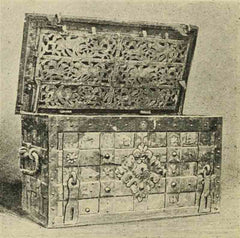 When we talk about Spanish shipwreck treasure, it is almost always about Silver Reales (Pieces of Eight) and Gold Escudos (Doubloons) minted in New World mints of present day Mexico and South America. This is because most of the legendary shipwrecks are of Spanish treasure galleons making their way from New World mints to Cuba, where they staged for the journey back to Spain, or from Cuba home to Spain.
When we talk about Spanish shipwreck treasure, it is almost always about Silver Reales (Pieces of Eight) and Gold Escudos (Doubloons) minted in New World mints of present day Mexico and South America. This is because most of the legendary shipwrecks are of Spanish treasure galleons making their way from New World mints to Cuba, where they staged for the journey back to Spain, or from Cuba home to Spain.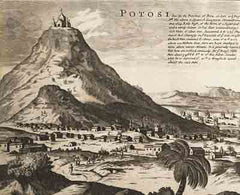 Spanish Treasure Coin Mine Potosi Peru BoliviaBut Sao Jose left from Lisbon, and the treasure she was carrying was intended for use in East Indies trade. When silver reales arrived from the New World to Spain, some of the silver was melted down to make reales at Spanish mints, while other New World reales went into trade directly.
Spanish Treasure Coin Mine Potosi Peru BoliviaBut Sao Jose left from Lisbon, and the treasure she was carrying was intended for use in East Indies trade. When silver reales arrived from the New World to Spain, some of the silver was melted down to make reales at Spanish mints, while other New World reales went into trade directly.
So Sao Jose’s recovered treasure is unusual, in that both New and Old World mints are represented… making the study of these coins even more interesting.
To see our exclusive collection of Sao Jose shipwreck coin jewelry, click here>>>
To browse our collection of Portuguese treasure coin jewelry, click here>>>
